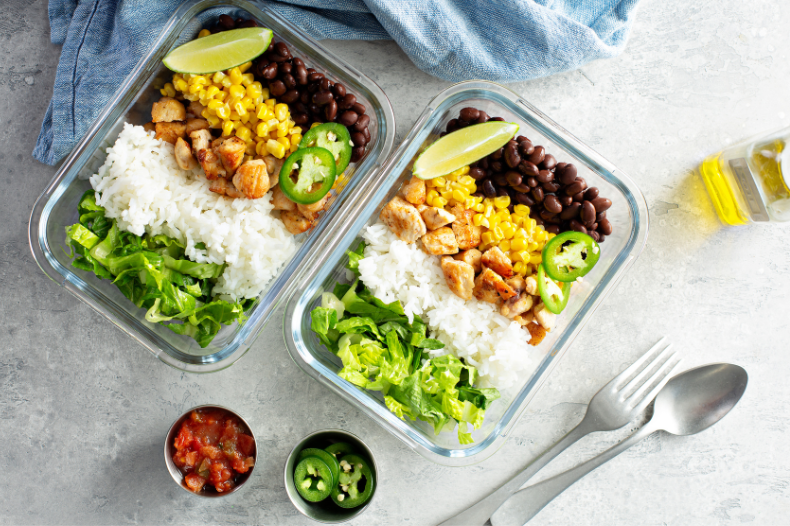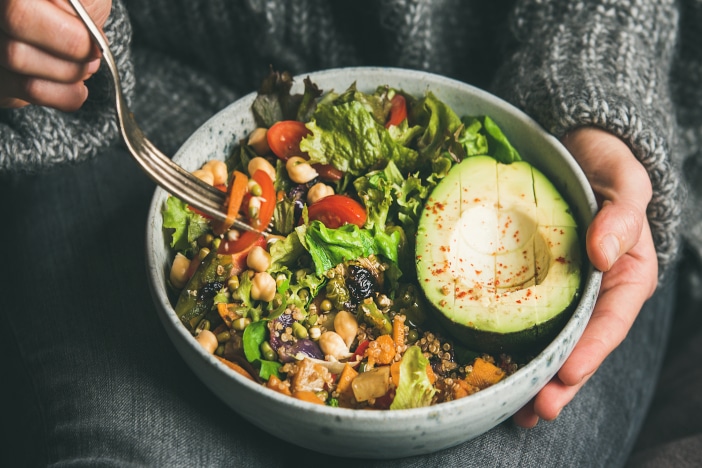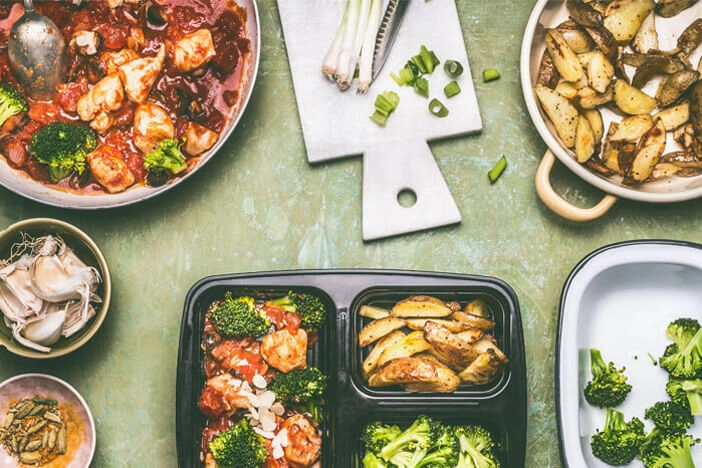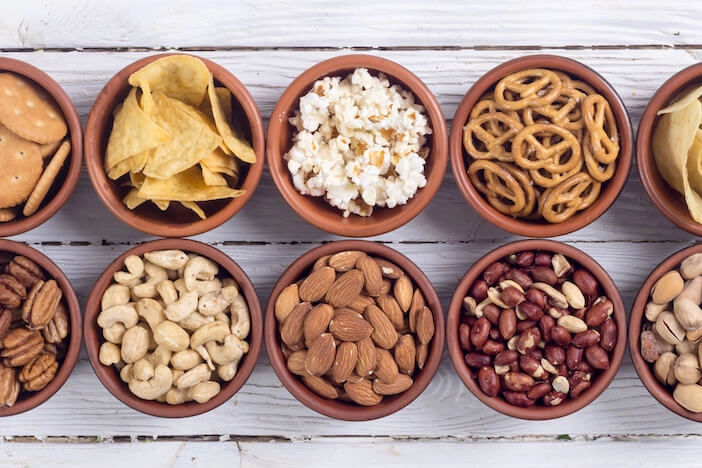- Review – Quiz
- 7 mindfulness techniques for conscious eating
- 5 examples of self-reflection and goal setting
- Planning and preparing: The be-all and end-all for a healthy diet
- Change Happens in the Mind: 5 Methods to Get Rid of Unhealthy Behaviors
- Movement – Everday and essential!
- Change your behavior and lose weight without restrictions!
- The Essentials (brief)
- 5 simple ways you can implement
- Your Homework
1. Review - Quiz
Mindful eating, self-reflection and goal setting – all principles of behavior change! But how exactly can you use them to achieve your goal?
The journey to a healthy lifestyle is shaped not only by what we eat, but also by our attitude towards food and the conscious handling of our habits.
In this lesson we delve into the practical application of various mindfulness techniques in the context of nutrition. From self-reflection and goal setting to meal planning and preparation and the use of cognitive behavioral techniques, we explore how these aspects can contribute not only to sustainable weight loss, but also to a positive change in our relationship with food.
2. 7 mindfulness techniques for conscious eating

The art of conscious eating is a central part of a healthy diet. This section introduces seven powerful mindfulness techniques to help you establish a deeper connection with your food and enjoy it more consciously.
2.1 Breath focusing
- Breath focusing involves consciously directing attention to your breathing to create inner calm.
- Example: Breathe in and out deeply, focusing on the rhythm of your breathing.
- Application: Breathe deeply before eating to create a calm dining atmosphere.
2.2 Visualization
- Visualization uses the imagination to create positive images in the mind.
- Example: Imagine yourself eating consciously and with pleasure.
- Application: Visualize before a positive eating experience to promote conscious eating.
-
2.3 Gratitude practice
- Gratitude practice emphasizes consciously appreciating positive aspects in life.
- Example: Write down three things you are grateful for every day.
- Application: Express gratitude for the food before eating and write it down.
2.4 Sound meditation
- Sound meditation uses sounds to deepen mindfulness and calm the mind.
- Example: Listen consciously to sounds in your surroundings.
- Application: Soft background music while eating for a relaxed atmosphere.
2.5 Taste meditation
- In taste meditation the focus is on the conscious perception of taste sensations.
- Example: Consciously take small bites and feel the taste intensely.
- Application in a nutritional context: Consciously use small portions to enjoy the taste.
2.6 Pause meditation
- Pause meditation emphasizes short moments of mindfulness in everyday life.
- Example: Use short breaks to take a deep breath and capture the moment.
- Application: Short breaks between bites and courses to maintain focus.
2.7 Self-compassion
- Self-compassion involves kind self-care and acceptance.
- Example: Speak lovingly to yourself, especially in stressful moments.
- Application: Self-compassion when you deviate from your nutritional path instead of being self-critical.
3. 5 examples of self-reflection and goal setting

Self-reflection and goal setting are not abstract concepts, but powerful tools that can be put into practice through concrete techniques and strategies. It is always important to look for triggers (self-reflection) and set SMART goals (specific, measurable, achievable, relevant and time-bound goals).
A practical example
Anna keeps a food diary and realizes that she often snacks when she is stressed. After identifying this trigger, she sets the goal of developing alternative coping strategies. Your SMART goal is: “In the next four weeks, I will turn to healthy snacks like fruit or nuts in stressful moments and manage my emotions differently without resorting to unhealthy snacks.”
Through this combination of self-reflection and clear goals, Anna is able to deal with her stress more consciously and change her habits positively. Practicing these techniques not only leads to a better understanding of your eating habits, but also lays the foundation for a sustainable path to weight loss.
Below we will show you how you can change certain behaviors through self-reflection and goal setting.
3.1 Identify emotional eating behavior
- Self-reflection: Write down in a diary when you reach for unhealthy snacks. Analyze your feelings in these moments
- Goal setting: Set yourself the goal of finding alternative ways to deal with stress, for example through meditation or going for a walk.
3.2 Develop meal awareness
- Self-reflection: Be aware of whether you are eating because you are hungry or bored. Write down these thoughts.
- Goal Setting: Set a goal to only eat when you are truly hungry and find alternative activities to relieve boredom.
3.3 Improve portion control
- Self-reflection: Notice how large your portions are and whether you often eat everything, even when you’re full.
- Goal setting: Set a goal to choose smaller portions and consciously stop eating when you feel satisfied.
3.4 Recognize eating triggers/habits
- Self-reflection: Identify specific places, situations, habits, or emotions that lead to overeating.
- Goal Setting: Set a goal to develop strategies to resist these triggers or find alternative responses.
3.5 Increase motivation through milestones
- Self-reflection: Regularly reflect on your progress and the obstacles on the way to your goal.
- Goal Setting: Set a goal to define small milestones and reward yourself for achieving each goal.
These practical application examples show how self-reflection techniques combined with clear goals can be individually adapted to promote conscious and healthy eating. By recognizing patterns and setting clear goals, you lay the foundation for sustainable change.
4. Planning and preparing: The be-all and end-all for a healthy diet

The keys to weight loss success often lie in wise planning and effective preparation. This section introduces various techniques and strategies to help you plan and prepare your meals to encourage more conscious eating habits and achieve healthy eating goals.
4.1 Weekly meal planning
- Plan your main meals in advance each week.
- Once a week, sit down and think about what meals you want to eat.
- Make sure you have a balanced diet that contains all the necessary nutrients.
- This not only allows for a healthy diet, but also makes it easier to buy the groceries you need.
4.2 Create shopping list
- Create a shopping list based on your meal plan.
- After you’ve planned your meals, write down all the ingredients you’ll need.
- When shopping, strictly follow this list to avoid spontaneous purchases of unhealthy foods.
4.3 Prepare healthy snacks
- Have pre-portioned healthy snacks on hand.
- Cut vegetables into manageable portions
- Provide nuts in snack bags
- Portion fruit into small containers.
- These prepared snacks are perfect for on-the-go meals and help combat cravings with healthy options.
4.4 Meal Prep
- Prepare meals in advance.
- Use part of your weekend to cook larger batches of healthy meals.
- Portion them into individual portions and freeze them.
- Not only does this save time, but it ensures you always have a healthy option available.
4.5 Keep healthy options on hand
- Make sure healthy foods are easily accessible.
- Place healthy foods like yogurt, vegetable sticks, or hard-boiled eggs in the refrigerator at eye level.
- This makes it easier to choose healthy options when hunger strikes.
4.6 Themed days
- Introduce themed meal planning days.
- Incorporate variety by assigning themes to certain days, such as a “Meatless Monday.”
- This makes planning more interesting and promotes diversity in nutrition.
Through conscious decisions and structured preparation, you will create an environment that supports your weight loss goals and encourages positive eating habits.
5. Change happens in the mind: 5 methods to get rid of unhealthy behaviors
The following cognitive behavior change techniques provide you with a diverse range of tools to promote positive changes in diet and weight loss. Let’s take a closer look at how these techniques can be practically applied to achieve your goals.
5.1 Self regulation through reward

This technique is based on rewarding positive behaviors to increase motivation and persistence.
Example: After a week of healthy eating, reward yourself with a small, non-food-related treat, like a spa night.
5.2 Attitude change
This method involves examining and adjusting attitudes and beliefs related to diet and body image.
Example: Replace the thought “I have to be perfect” with “It’s okay to make small exceptions occasionally.”
5.3 Strengthen self-efficacy expectations
Focus on believing that you are capable of achieving your nutritional goals, even when obstacles arise.
Example: Emphasize your successes and remind yourself of how you have overcome challenges in the past.
5.4 Cognitive distraction
Consciously direct your attention away from negative thoughts towards positive or neutral content.
Example: When negative thoughts arise, shift your attention to something positive. For example, do you think a lot about what bothers you about your body? Then try to redirect those thoughts: What do you like about yourself?
5.5 Effective Education
The focus is on recognizing and understanding emotions related to food in order to make more conscious decisions.
Example: Ask yourself what emotions you are feeling before you eat and consider whether it is hunger or emotional eating.
6. Movement - everyday and essential!
Exercise in everyday life is crucial for physical and mental health. Regular exercise can achieve positive effects such as improved physical fitness, increased well-being and stress reduction. Small steps, such as short walks, active breaks or consciously opting out of conveniences such as the elevator, can make a significant difference. Overcoming your inner weakness and creating habits are the key to long-term success. Remember that every movement counts and positive changes in everyday life are possible. Start small, find joy in movement and experience how even small steps can make a big difference to your health!
7. Change your behavior and and lose weight without restrictions!
In this lesson you learned how you can work practically and holistically on your behavior in order to lose weight in the long term and develop a healthy lifestyle.
Mindfulness techniques, such as a focus on breathing, visualization and gratitude practice, promote mindful eating. Practical examples of self-reflection and goal setting show how individual behavior can be changed through clear goals.
A healthy diet means planning and preparation – which is illustrated by concrete techniques such as weekly meal planning and meal prep. Cognitive behavioral techniques help you overcome unhealthy behaviors by addressing self-regulation, attitudes, self-efficacy, cognitive distraction, and affective education.
The Essentials (brief)
- Mindfulness techniques for conscious eating
-
-
- Breath focusing: Consciously directing your attention to your breath creates inner peace, especially before eating.
- Visualization: Using imagination to create positive images of conscious and enjoyable eating promotes a conscious eating experience.
- Gratitude Practice: Consciously appreciating positive aspects in life, including gratitude for food, contributes to mindful eating.
- Sound meditation: Consciously perceiving sounds in the environment, for example through quiet background music while eating, deepens mindfulness.
- Taste meditation: Consciously perceiving taste sensations by consciously taking small bites promotes a more intense enjoyment experience.
- Pause meditation: Emphasizing short moments of mindfulness in everyday life, such as taking deep breaths between bites, helps maintain focus.
- Self-compassion: Kind self-care and acceptance, especially in stressful moments or when deviating from the nutritional path.
-
- Planning and preparing for a healthy diet
-
-
- Weekly Meal Planning: Choosing balanced meals planned in advance not only promotes healthy eating but also makes shopping easier.
- Create a shopping list: Write down all the required ingredients according to the meal plan to avoid spontaneous purchases of unhealthy foods.
- Prepare Healthy Snacks: Pre-portioned healthy snacks like vegetables, nuts, and fruits help combat cravings with healthy options.
- Meal Prep: Preparing meals in advance, portioning and freezing to save time and always have healthy options available.
- Keep healthy options close at hand: Placing healthy foods in accessible areas makes it easier to choose healthy options.
-
- Cognitive Behavioral Techniques for Behavior Change:
-
- Self-regulation through reward: Rewarding positive behavior, such as a wellness evening after a week of healthy eating, strengthens motivation and stamina.
- Attitude change: Reviewing and adjusting attitudes and beliefs related to diet and body image to set more realistic goals.
- Strengthen self-efficacy: Focusing on the belief that one is capable of achieving nutritional goals, even when obstacles arise.
- Cognitive Distraction: Consciously shifting attention from negative thoughts to positive or neutral content to promote a positive mindset.
- Affective literacy: Recognizing and understanding emotions related to food to make more conscious decisions.
5 simple things you can implement
- Try mindfulness techniques: For the following week, resolve to try a new mindfulness technique every day. For example, start on Monday with breathing focus. Before each meal, sit down and breathe deeply in and out 10 times.
- Meal Prep: Our program does a lot of the work for you in terms of meal planning and shopping list creation. Try out whether you can improve the plan by cooking more in advance or setting up theme days.
- Try cognitive behavior change techniques: Choose one of the methods that appeals to you most for the coming weeks. How about a reward? Set yourself a goal, e.g. if you stick to your plan perfectly, treat yourself to a trip to the thermal baths and see how you get on with it.
- Development of stress management strategies: Identify stress triggers and develop alternative coping strategies. This may include incorporating relaxation techniques, such as breathing exercises or taking short breaks, in stressful situations.
- Seek social support:Share your goals and progress with friends or family members. Social support has a motivating effect and helps to overcome challenges together.
Your Homework
Do you remember your SMART goal from the last lesson? Now it’s time to develop a plan to achieve this. For this we use the WOOP method. The best thing to do is to write everything down and hang up your “weight loss plan” in a clearly visible place.
Wish
- Formulate a clear and positive wish related to your weight loss.
- For example: “I want to develop healthier eating habits and lose two kilograms in the next four weeks.”
- This is your SMART goal from the last lesson.
Outcome
- Vividly describe the positive outcomes that come with fulfilling your wish.
- Visualize how these changes might impact your well-being, energy, and self-satisfaction.
Obstacle
- Identify potential obstacles or challenges that could prevent you from achieving your goal.
- Be honest and specific.
- Example: “The temptation of snacks during stressful moments.”
Plan (Plan)
- Develop concrete strategies to overcome these obstacles.
- Develop a detailed plan for how you will deal with the identified challenges.
- Example: “When stress comes up, I will do a quick breathing exercise or prepare a healthy snack instead.”






